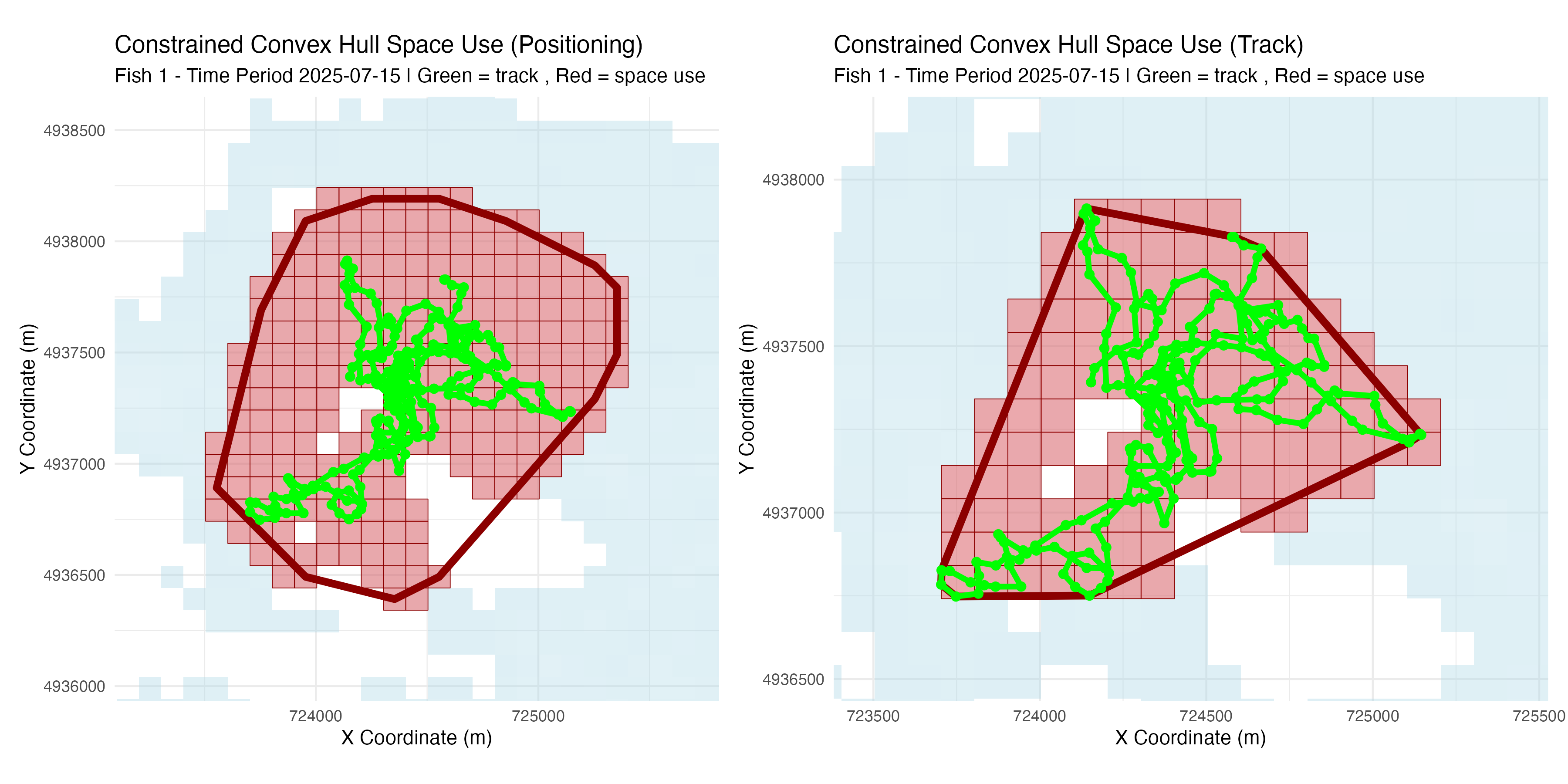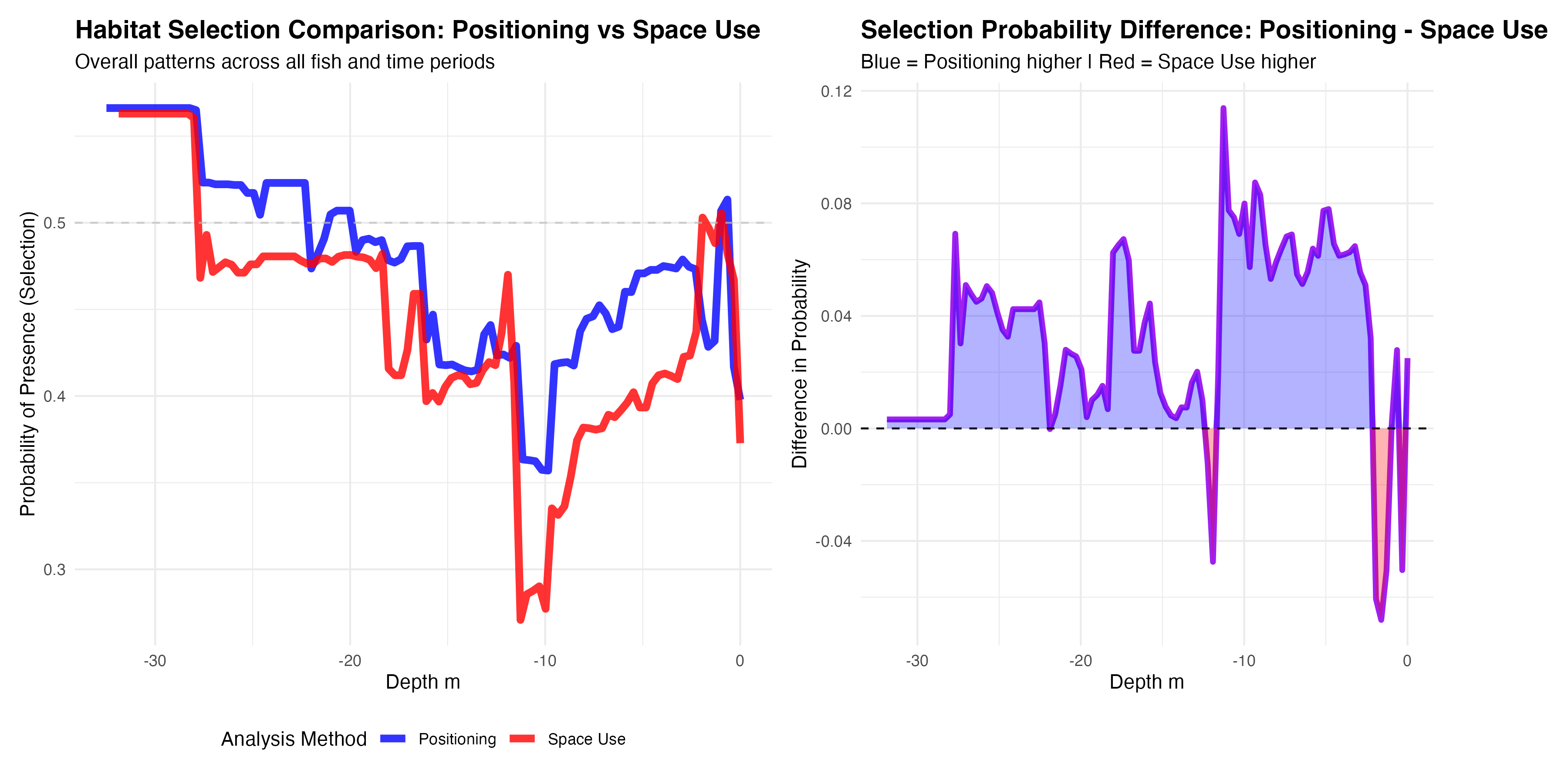Tools for Analyzing Acoustic Telemetry Data - Positioning, Simulation, & Array Design
positionR provides comprehensive tools for acoustic telemetry array design, fish movement simulation, animal positioning using Weighted Average Detection Efficiency (WADE) methodology, and point generation for habitat selection studies that integrate sampling regions. One major advancement is the integration of receiver detection efficiency models into fish positioning, array performance, and habitat selection. The integrated analysis ecosystem provides powerful methodology to assess positioning and habitat selection model performance with simulations to inform best practices for assessing these metrics with real world aquatic animal tracking studies.
Features
🎯 Array Design & Optimization
- Multiple receiver placement strategies (regular, spaced, random patterns)
- Distance-based detection efficiency model generation with depth integration
- System-wide detection coverage analysis
- Array performance evaluation and optimization
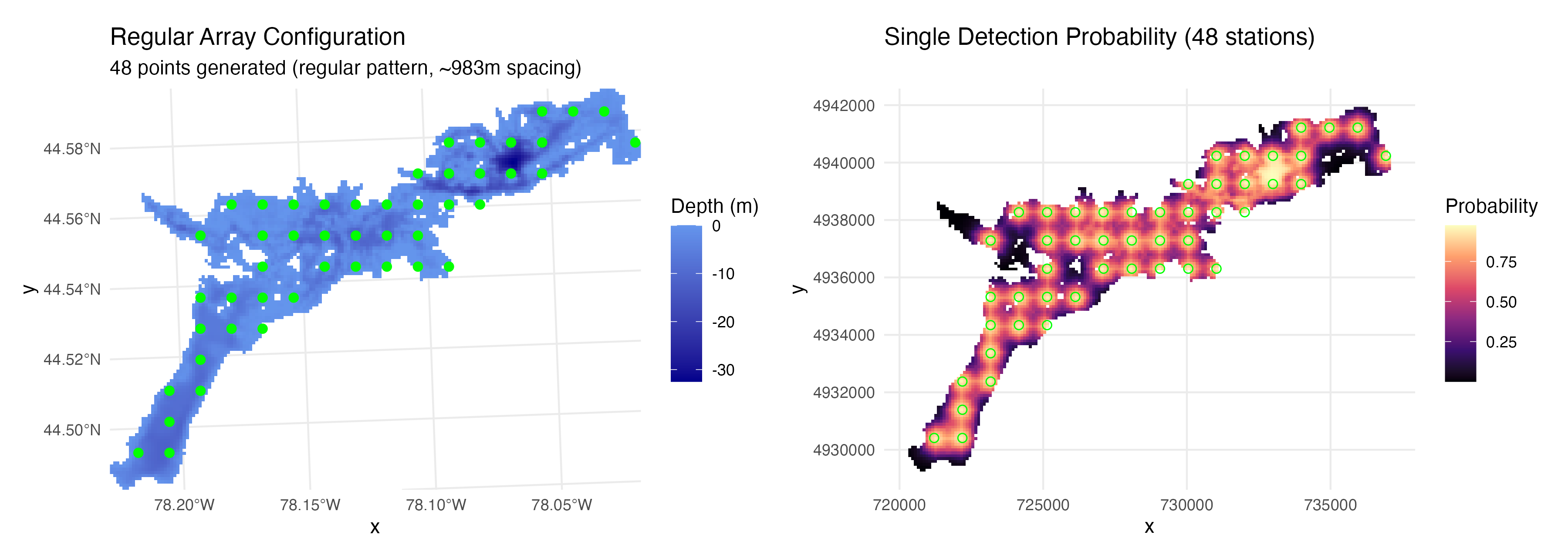
🐟 Movement Simulation
- Generate movement tracks with correlated random walk models
- Produce detection patterns from tracks based on detection efficiency
- Compare positioning and habitat selection to true track locations for optimization
- Advanced movement models integrate behavioral states relative to species tendencies and environmental conditions (e.g., temperature). Extensible framework for users to build upon
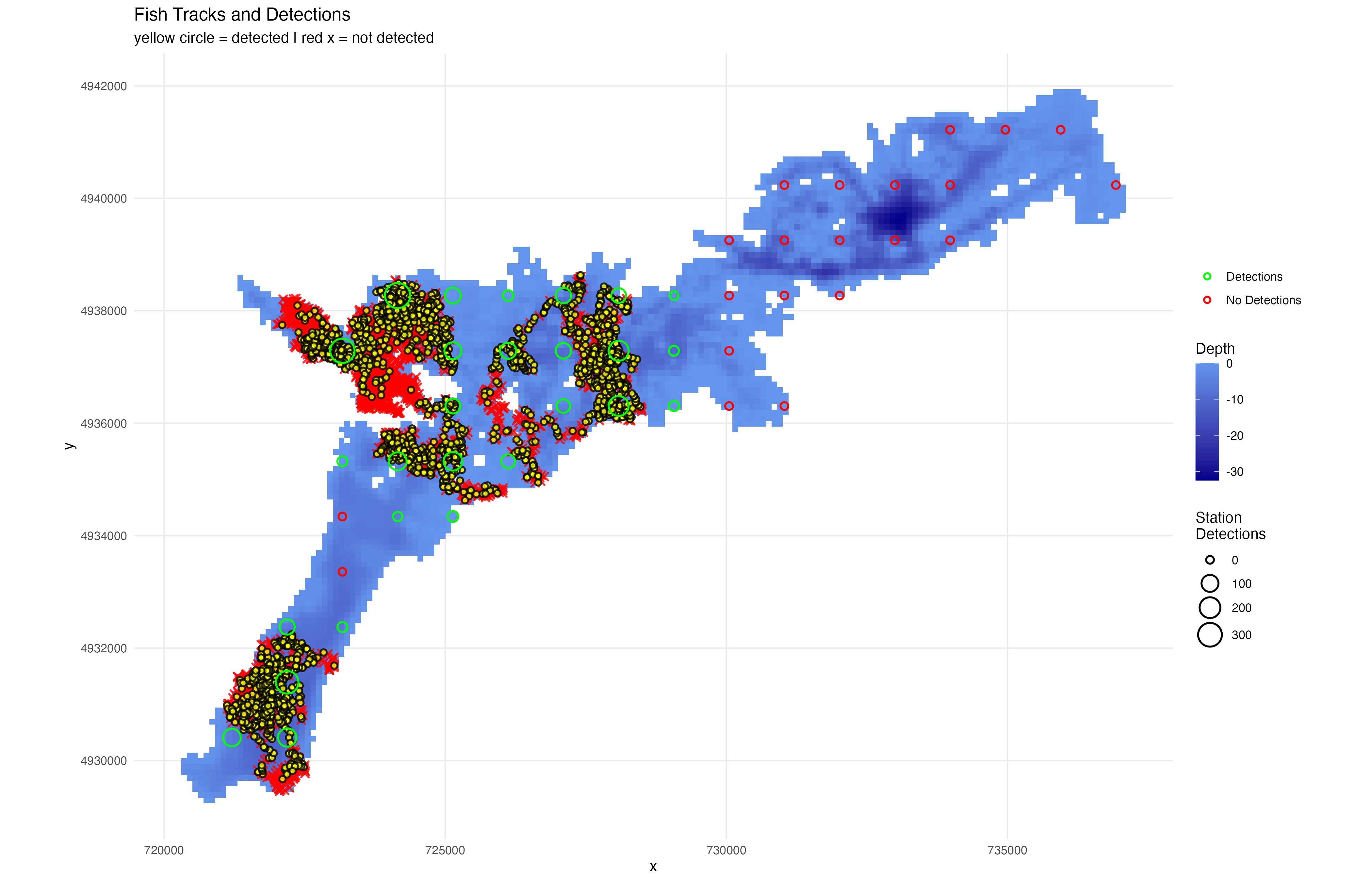
📍 WADE Positioning
- Weighted Average Detection Efficiency animal positioning uses detection efficiency information to position animals
- Flexible detection model applications and temporal aggregation (e.g., hourly, daily)
- Analytical tools for calculating home ranges and habitat selection from WADE positions
- Simulations can inform best practices for positioning, depending on endpoints
- Field data integration for real acoustic telemetry datasets
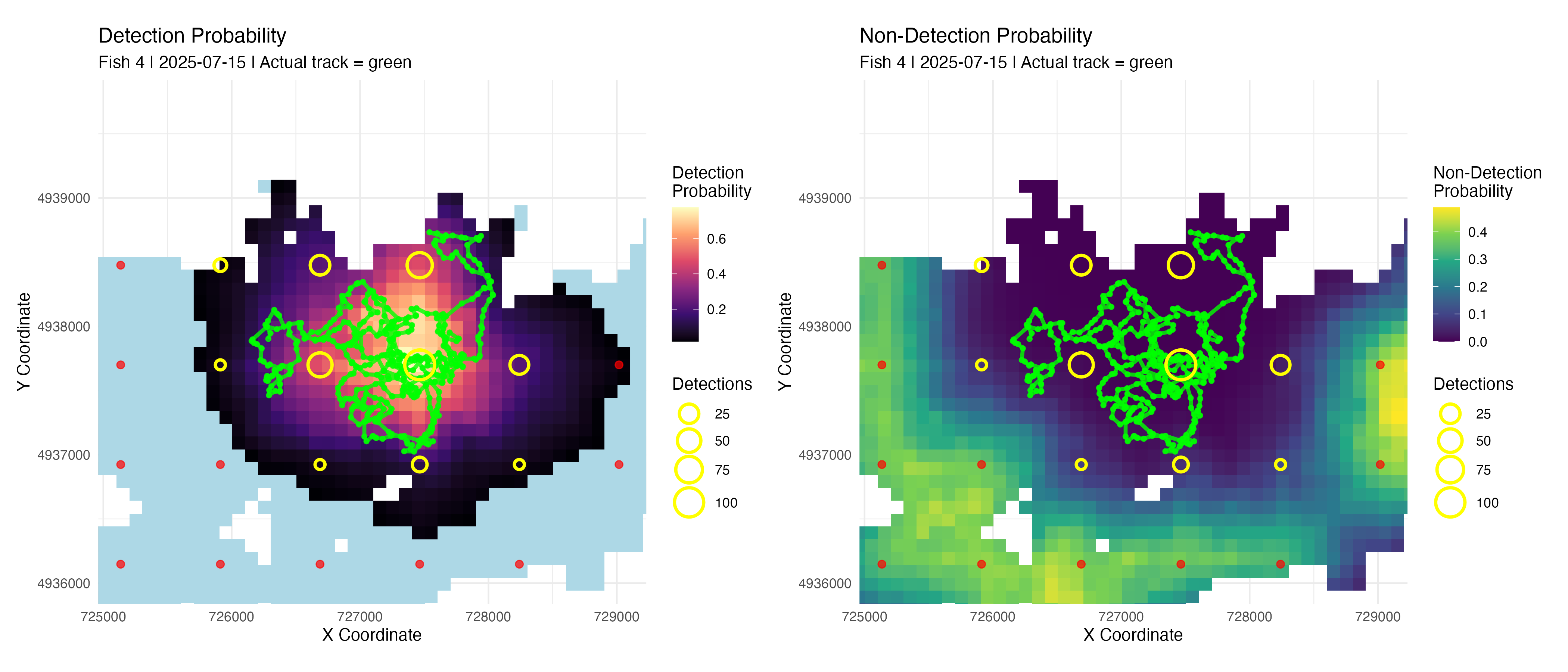
Installation
Install the development version from GitHub:
# Install devtools if you haven't already
install.packages("devtools")
# Install positionR with vignettes
devtools::install_github("jakebrownscombe/positionR", build_vignettes = TRUE)Quick Start: Array Design Simulation
library(positionR)
# Load example depth data
data("depth_raster")
raster::crs(depth_raster) <- "EPSG:32617"
# 1. Generate receiver array (100 stations, regularly spaced)
stations <- generate_regular_points(depth_raster, n_points = 100, seed = 123)
# 2. Calculate cost-weighted distances
station_distances <- calculate_station_distances(
raster = depth_raster,
receiver_frame = stations,
max_distance = 30000,
station_col = "station_id"
)
# 3. Create detection efficiency model
logistic_DE <- create_logistic_curve_depth(
min_depth = 2, max_depth = 25,
d50_min_depth = 150, d95_min_depth = 50,
d50_max_depth = 300, d95_max_depth = 100,
plot = TRUE
)
# 4. Calculate system detection coverage
system_DE <- calculate_detection_system(
distance_frame = station_distances,
receiver_frame = stations,
model = logistic_DE$log_model,
threshold = 0.8,
output_type = "cumulative"
)
# 5. Simulate fish movement with detections
start_time <- as.POSIXct("2025-07-15 12:00:00", tz = "UTC")
fish_simulation <- simulate_fish_tracks(
raster = depth_raster,
station_distances = station_distances,
n_paths = 5,
n_steps = 1440, # 24 hours at 60-second intervals
time_step = 60,
start_time = start_time,
species = "walleye" # Enables behavioral states
)
# 6. Visualize and analyze results
plot_fish_tracks(fish_simulation, depth_raster, stations)
analyze_detection_performance(fish_simulation)Quick Start: WADE Positioning with Field Data
library(positionR)
# Load field data (included with package)
data("stoney_fish_detections") # Detection events
data("stoney_rx_deploy") # Receiver deployments
data("depth_raster") # Study area bathymetry
# 1. Calculate station distances for WADE positioning
station_distances <- calculate_station_distances(
raster = depth_raster,
receiver_frame = stoney_rx_deploy,
max_distance = 30000,
station_col = "station_id"
)
# 2. Prepare detection data for WADE analysis
wade_data <- prepare_detection_data_for_wade(
detection_events = stoney_fish_detections,
receiver_deployments = stoney_rx_deploy,
start_time = as.POSIXct("2023-10-15 00:00:00", tz = "UTC"),
end_time = as.POSIXct("2023-10-29 23:00:00", tz = "UTC"),
time_aggregation_method = "daily"
)
# 3. Run WADE positioning algorithm
positioning_results <- calculate_fish_positions(
detection_data = wade_data,
station_distances = station_distances,
logistic_model = logistic_DE$log_model,
positioning_method = "WADE",
min_det_threshold = 1,
information_weighting = TRUE,
crs = "EPSG:32617"
)
# 4. Visualize positioning results
plot_fish_positions(
positioning_results = positioning_results,
raster = depth_raster,
receiver_frame = stoney_rx_deploy,
plot_type = "integrated",
time_filter = "2023-10-27"
)Core Function Categories
🎯 Array Generation
-
generate_regular_points()- Specific number of regularly spaced receivers -
generate_spaced_points()- Receivers with defined minimum spacing
-
generate_random_points()- Randomly distributed receivers
📡 Detection Modeling
-
create_logistic_curve_depth()- Distance-depth detection efficiency models -
calculate_station_distances()- Cost-weighted distance calculations -
calculate_detection_system()- System-wide detection probability surfaces
🐟 Movement & Positioning
-
simulate_fish_tracks()- Behavioral movement simulation with species parameters -
prepare_detection_data_for_wade()- Process field detection data -
calculate_fish_positions()- WADE positioning algorithm
📈 Space Use Analysis
-
calculate_space_use()- Multiple space use estimation methods -
generate_random_points_in_space_use()- Point sampling from space use areas -
generate_space_use_absences()- Generate absence points for habitat analysis -
analyze_comparative_habitat_selection()- Compare positioning vs tracking data
🎨 Visualization
-
plot_fish_tracks()- Movement paths with detection events -
plot_fish_positions()- WADE positioning probability surfaces
-
plot_space_use()- Space use area visualizations -
plot_behavioral_states()- Behavioral state time series -
plot_depth_selection()- Habitat selection analysis plots
📊 Analysis
-
analyze_detection_performance()- Detection system performance metrics -
analyze_behavioral_temperature()- Temperature-behavior interactions -
compare_space_use_thresholds()- Space use method comparisons
Included Datasets
-
depth_raster- Example bathymetry raster for system testing -
stoney_fish_detections- Real walleye detection data from Stoney Lake -
stoney_rx_deploy- Receiver deployment metadata -
daily_temperature- Daily water temperature data for behavioral modeling
📚 Tutorials & Vignettes
Comprehensive step-by-step tutorials demonstrate the full capabilities of positionR:
🐟 WADE Positioning Tutorial
Complete workflow for fine-scale fish positioning using WADE methodology
Learn how to apply WADE positioning to real acoustic telemetry data, including detection data preparation, model fitting, positioning calculations, and space use analysis. Covers advanced topics like behavioral state modeling, temperature effects, and comparative analysis between positioning methods.
vignette("WADE_Simulation", package = "positionR")📡 Array Design & Movement Simulation
Optimize receiver arrays and simulate realistic fish movements
Design effective receiver arrays using multiple placement strategies, model detection efficiency based on environmental conditions, simulate realistic fish movements with behavioral states, and evaluate system performance before deployment. Includes habitat selection analysis and presence-absence modeling.
vignette("Array_Design_Simulation", package = "positionR")🔍 Browse All Tutorials
browseVignettes("positionR")Online Documentation: Visit our package website for enhanced tutorials with interactive examples and detailed methodology explanations.
Key Applications
- 🔬 Array Design: Optimize receiver placement for detection coverage
-
📍 Animal Positioning: Locate animals using WADE methodology
- 🏠 Habitat Selection: Analyze space use and habitat preferences
- 🌡️ Behavioral Ecology: Study temperature-dependent movement patterns
- 📊 System Evaluation: Assess performance of existing telemetry arrays
- 🎯 Simulation Studies: Test scenarios and validate methodologies
Methodology: WADE Positioning
The Weighted Average Detection Efficiency (WADE) methodology provides probabilistic animal positioning by:
- Detection Integration: Combining detection events with receiver-specific detection probabilities
- Non-detection Integration: Incorporating information from receivers that should have detected the animal but didn’t
-
Temporal Aggregation: Integrating data across user-defined time periods
- Spatial Weighting: Weighting positions by detection efficiency and detection frequency
- Uncertainty Quantification: Providing probability surfaces rather than point estimates
Dependencies
Key dependencies include:
-
Spatial:
raster,sf,sp,gdistance- spatial data handling and analysis -
Visualization:
ggplot2,ggridges,scales- publication-quality plots -
Data:
dplyr,tidyr,lubridate- data manipulation and processing
-
Movement:
circular,FNN- movement modeling and nearest neighbor calculations -
Analysis:
randomForest- habitat selection modeling
Citation
If you use positionR in your research, please cite:
Brownscombe, J.W. (2025). positionR: Weighted Average Detection Efficiency (WADE)
Positioning for Acoustic Telemetry. R package version 1.0.0.
https://github.com/jakebrownscombe/positionRContributing
Contributions are welcome! Please:
- Fork the repository
- Create a feature branch (
git checkout -b feature/new-feature) - Commit changes (
git commit -am 'Add new feature') - Push to branch (
git push origin feature/new-feature)
- Create a Pull Request
License
This project is licensed under the GPL-3 License - see the LICENSE file for details.
Contact & Support
-
Author: Dr. Jacob Brownscombe
- Email: jakebrownscombe@gmail.com
- GitHub: @jakebrownscombe
- Issues: Report bugs or request features


